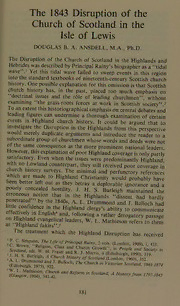
The 1843 Disruption of the Church of Scotland in the Isle of Lewis PDF
Preview The 1843 Disruption of the Church of Scotland in the Isle of Lewis
The 1843 Disruption of the Church of Scotland in the Isle of Lewis DOUGLAS B. A. ANSDELL, M.A., Ph.D. The Disruption of the Church of Scotland in the Highlands and Hebrides was described by Principal Rainy’s biographer as a “tidal wave”.1 Yet this tidal wave failed to sweep events in this region into the standard textbooks of nineteenth-century Scottish church history. One possible explanation for this omission is that Scottish church history has, in the past, placed too much emphasis on doctrinal issues and the role of leading churchmen”, without examining “the grass-roots forces at work in Scottish society”.2 To an extent this historiographical emphasis on central debates and leading figures can undermine a thorough examination of certain events in Highland church history. It could be argued that to investigate the Disruption in the Highlands from this perspective would merely duplicate arguments and introduce the reader to a subordinate group of churchmen whose words and deeds were not of the same consequence as the more prominent national leaders. However, this explanation ofpoor Highland coverage is only partly satisfactory. Even when the issues were predominantly Highland, with no Lowland counterpart, they still received poor coverage in church history surveys. The minimal and perfunctory references which are made to Highland Christianity would probably have een better left out as they betray a deplorable ignorance and a poorly concealed hostility. J. H. S. Burleigh maintained the erroneous notion that in the Highlands “dissent had hardly penetrated by the 1840s, A. L. Drummond and J. Bulloch had „